McLeod Ian - Swimming Anatomy
Здесь есть возможность читать онлайн «McLeod Ian - Swimming Anatomy» весь текст электронной книги совершенно бесплатно (целиком полную версию без сокращений). В некоторых случаях можно слушать аудио, скачать через торрент в формате fb2 и присутствует краткое содержание. Год выпуска: 2009, ISBN: 2009, Жанр: Природа и животные, на английском языке. Описание произведения, (предисловие) а так же отзывы посетителей доступны на портале библиотеки ЛибКат.
- Название:Swimming Anatomy
- Автор:
- Жанр:
- Год:2009
- ISBN:978-0736075718
- Рейтинг книги:5 / 5. Голосов: 1
-
Избранное:Добавить в избранное
- Отзывы:
-
Ваша оценка:
- 100
- 1
- 2
- 3
- 4
- 5
Swimming Anatomy: краткое содержание, описание и аннотация
Предлагаем к чтению аннотацию, описание, краткое содержание или предисловие (зависит от того, что написал сам автор книги «Swimming Anatomy»). Если вы не нашли необходимую информацию о книге — напишите в комментариях, мы постараемся отыскать её.
Swimming Anatomy — читать онлайн бесплатно полную книгу (весь текст) целиком
Ниже представлен текст книги, разбитый по страницам. Система сохранения места последней прочитанной страницы, позволяет с удобством читать онлайн бесплатно книгу «Swimming Anatomy», без необходимости каждый раз заново искать на чём Вы остановились. Поставьте закладку, и сможете в любой момент перейти на страницу, на которой закончили чтение.
Интервал:
Закладка:
Figure 3.2Shoulder blade and neck.
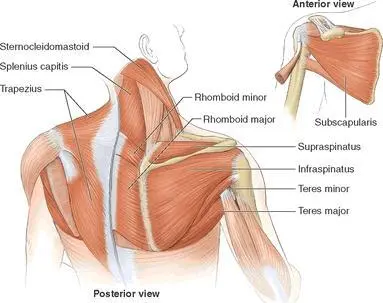
The next major muscle group is the positioner group, which is actually only one muscle that has three separate divisions—anterior, middle, and posterior. The deltoid is the shoulder cap muscle that drapes over the upper portion of the shoulder joint (figure 3.3). The deltoid is called the positioner group because it is the primary muscle involved in changing the position of the humerus and thus the entire arm. The anterior portion is responsible for flexing and internally rotating the shoulder joint. The posterior portion performs the opposite movements, extension and external rotation. The middle portion is responsible for lifting the arm to the side, which is the movement of abduction. The deltoid is most active during the recovery phase. Each portion plays an important role in moving the arm during the various stages of the recovery phase.
The final muscle group, the propellers, includes the latissimus dorsi and pectoralis major. This name is derived from the fact that these muscles are the primary force generators at the shoulder joint. Because of the large number of exercises that target these muscles, their contributions to the movement of a swimmer and associated exercises will be reviewed in the chapters covering the chest and back.
Figure 3.3Deltoid.
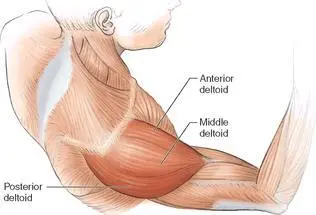
Forward Dumbbell Deltoid Raise

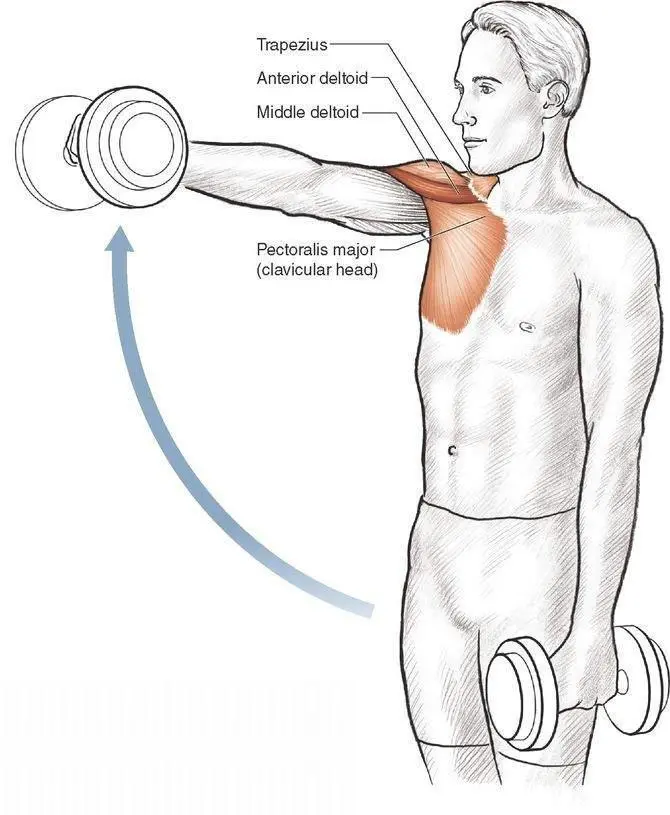
Execution
1. Stand and hold a dumbbell in each hand with your arms hanging at your sides and your palms facing your thighs.
2. Holding a slight bend in your elbows, raise the right dumbbell forward until it is level with your shoulders.
3. As you raise the dumbbell, slowly rotate your hands so that your palm faces the floor at the end of the exercise.
4. As you begin lowering the right dumbbell, initiate the movement of the left dumbbell.
Muscles Involved
Primary:Anterior deltoid
Secondary:Middle deltoid, trapezius, pectoralis major (clavicular head)
Swimming Focus
The anterior deltoid, the primary muscle engaged throughout this exercise, is a key player in the recovery process of butterfly, breaststroke, and especially backstroke. During butterfly it is active during the second half of the recovery, and during breaststroke it contributes by guiding the movements of the arm and hand from underneath the swimmer’s chest to a fully extended and elongated position, maximizing the efficiency of the stroke. The entire recovery phase of backstroke, from water exit until reentry, also relies on recruitment of the anterior deltoid. As the speed of the stroke increases and the need for rapid recovery increases, so does the demand placed on the muscle.
You can use this exercise to build on the scapular setting motion previously described. To do this exercise, stand with a tall, upright posture and focus on pinching your shoulder blade backward and downward. While holding it in this set position, perform the exercise. Have a partner monitor your movements from behind to make sure that you do not start to shrug your shoulders.
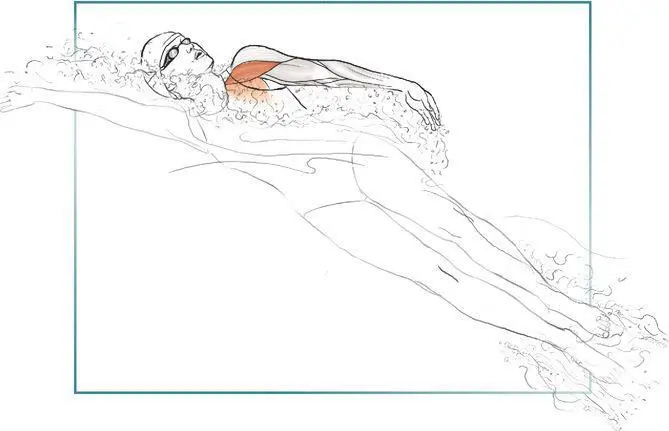
VARIATION Forward Deltoid Raise With Tubing
Tubing targets the same muscles, but because of the ease of varying the resistance by simply stretching or slackening the exercise tubing, this variation may be better than the dumbbell variation for an on-deck dryland program.

Lateral Dumbbell Deltoid Raise

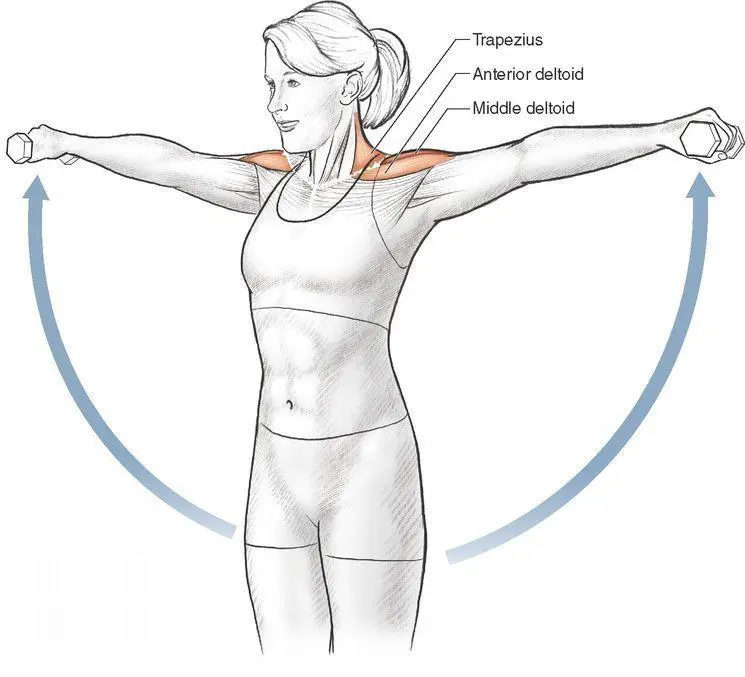
Execution
1. Stand and hold a dumbbell in each hand with your arms hanging at your sides and your palms facing your thighs.
2. With a slight bend in your elbows, raise the dumbbells to the side until they are level with your shoulders.
3. Slowly lower the dumbbells.
Muscles Involved
Primary:Middle deltoid
Secondary:Anterior deltoid, posterior deltoid, supraspinatus, trapezius
Swimming Focus
The primary focus of this exercise is the middle deltoid, one of the key muscles involved in the recovery phase of freestyle and butterfly. Unlike freestyle, butterfly lacks a body roll to aid in arm recovery, leading to heavy reliance on the deltoid muscle group, particularly the middle deltoid, to reposition the arm. As with the forward dumbbell deltoid raise, you should emphasize a tall, upright posture when performing this exercise. Like the forward dumbbell deltoid raise, this exercise is a good fundamental starting point for you to practice setting your scapula when performing upper-extremity exercises.

 SAFETY TIP
SAFETY TIP
To avoid overstressing the rotator cuff muscles, which are stabilizing the shoulder joint during the exercise, do not raise the dumbbells above shoulder height.
VARIATIONS
Lateral Deltoid Raise With Tubing
Tubing targets the same muscles, but because of the ease of varying the resistance by simply stretching or slackening the exercise tubing, this variation may be better than the dumbbell variation for an on-deck dryland program.
Overhead C
As mentioned previously, raising the arms above the level of the shoulders while the palms are facing down can be detrimental. The addition of the C at the end range changes the position of the shoulders in a way that allows movement of the arms above shoulder height while alleviating the concern of causing excessive stress to the rotator cuff. To complete the C movement, envision each hand as the hand of a clock. Starting in the 6 o’clock position with your palms facing down, rotate both upward in a clockwise manner to the 12 o’clock position.
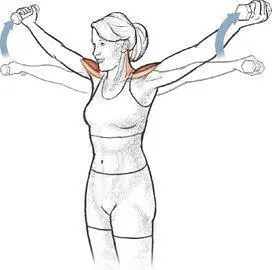
T Exercise

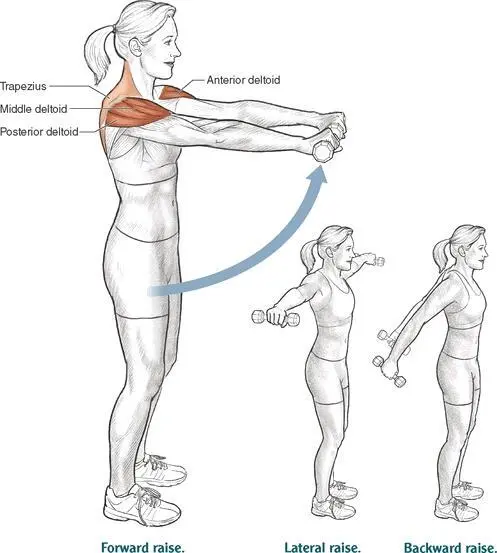
Execution
Читать дальшеИнтервал:
Закладка:
Похожие книги на «Swimming Anatomy»
Представляем Вашему вниманию похожие книги на «Swimming Anatomy» списком для выбора. Мы отобрали схожую по названию и смыслу литературу в надежде предоставить читателям больше вариантов отыскать новые, интересные, ещё непрочитанные произведения.
Обсуждение, отзывы о книге «Swimming Anatomy» и просто собственные мнения читателей. Оставьте ваши комментарии, напишите, что Вы думаете о произведении, его смысле или главных героях. Укажите что конкретно понравилось, а что нет, и почему Вы так считаете.











